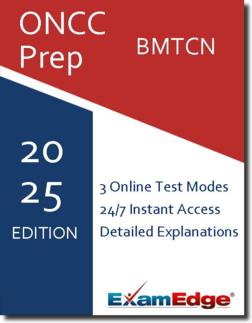ONCC BMTCN (BMTCN) Practice Tests & Test Prep by Exam Edge - Test Reviews
Based on 29 Reviews
- Real Exam Simulation: Timed questions and matching content build comfort for your ONCC BMTCN test day.
- Instant, 24/7 Access: Web-based ONCC Blood and Marrow Transplant Certified Nurse practice exams with no software needed.
- Clear Explanations: Step-by-step answers and explanations for your ONCC exam to strengthen understanding.
- Boosted Confidence: Reduces anxiety and improves test-taking skills to ace your ONCC Blood and Marrow Transplant Certified Nurse (BMTCN).

ONCC BMTCN (BMTCN) Practice Tests & Test Prep by Exam Edge - Review
ONCC Blood and Marrow Transplant Certified Nurse - Reviews
Excellent
Based on
145
reviews
“ I have taken the CBCN exam twice before and I failed. I purchased your test 2 and I reviewed it over and over again. I'm not a good test taker but your test taught me how to eliminate wrong answers and choose the correct one. Yesterday, I took the CBCN test and I passed!!!! I'm so very happy and doi ...
Read More
Evelyn C. , Harbor City CA
See why our users from 154 countries love us for their exam prep! Including 29 reviews for the ONCC BMTCN exam.
Exam Edge is an Industry Leader in Online Test Prep. We work with our Institutional Partners to offer a wide array of practice tests that will help you prepare for your big exam. No Matter how niche field of interest might be, were here to help you prepare for your test day.
| 2.8M | 4.5M | |
| Users | Tests Taken | |
| 100K | 19 | |
| Unique Exams | Years in Business | |


